How to create a Pivot Table report
Pivot tables - also known as a "crosstab", "cross-tabulation", "matrix" - allow you to summarize and analyze data in terms of groups; with pivot tables, you can perform comparisons (esp. period over period), explore trends, and get answers to questions like "how many", "what is happened" and "why". Nowadays pivot tables remain the most useful way to explore data both by non-IT users and professionals.
With SeekTable pivot tables are no longer just for Excel experts: literally anyone can create useful pivot tables just in a few clicks:
- Connect to your data: upload a CSV file or setup a database connection.
- Add a new report: click "Create Report", or choose "+" next to cube's name in the left menu.
- Keep "Report Type" option at "Pivot table"
-
Choose grouping criteria: what columns to use for "Rows" and/or "Columns".Hold CTRL to select multiple items at once.
- Choose a measure (aggregate function) to display in the pivot table: this may be count of rows, sum or average of the column. SeekTable will calculate aggregates for each row x column intersection. You can choose multiple measures at once.
- Click the "Apply" button
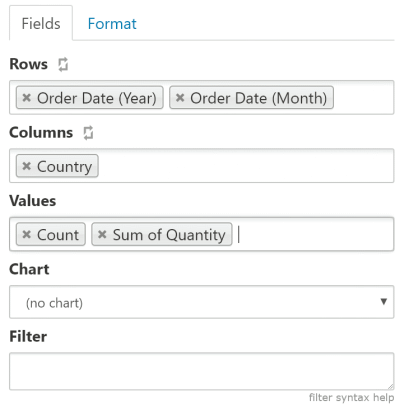
|
→ |

|
Sort Pivot Table
You can order table rows and columns in the following ways:
-
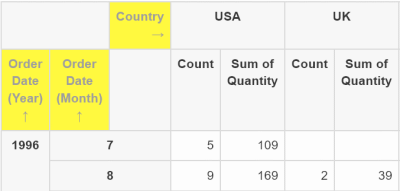 By labels: order by values of the columns that are selected for "Rows" or "Columns". This is default sort option.
To change order direction just click the appropriate header at the top-left corner of the table:
By labels: order by values of the columns that are selected for "Rows" or "Columns". This is default sort option.
To change order direction just click the appropriate header at the top-left corner of the table:
- ← indicates A-Z order (ascending)
- → indicates Z-A order (descending)
-
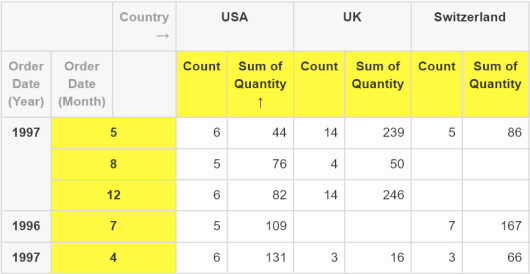 By values: order by the table's row (or column) values - that are calculatation results of the measure.
To sort by a concrete row or column values click the last grouping level label.
By values: order by the table's row (or column) values - that are calculatation results of the measure.
To sort by a concrete row or column values click the last grouping level label.
- It is possible to keep the order of groups by labels, and order by values only items in the last grouping level by checking "Sort by value last level only" option ("Format" tab).
- Both rows and columns may be ordered by values if at least one axis is ordered by totals.
Filter Pivot Table
You can exclude some rows or columns (or show only concrete rows/columns) in the same way as you can do that in Excel:

Note that checkboxes reflect only items that are present in the table (or items that where excluded explicitely, see below). If some items are filtered, the "(all)" checkbox will be in an indeterminate state (neither unchecked nor checked); you can quickly remove all filters for the exact dimension/column by checking "(all)".
In addition to that, you can manually enter filtering conditions in the Filter textbox:
- Keywords for the same axis (rows or columns) are combined with OR. To force AND use
+to combine conditions:year=2023+month=Jan - To specify a keyword for concrete dimension's use
dimension_keyword:prefix, for example:country:USA. Prefix should match at least one dimension's label.
For exact matches use=comparison:country=USA.
For number-type dimension it is possible to specify a comparison with a number:year>2020. - To match a phrase use quotes:
name:"John Smith" - To exclude matched items use
-prefix, for example:-Venezuela. - Show only top-N (or bottom-N) items in dimension's groups:
country:top(5)orcountry:"top(5, 1)"(where "1" is a zero-based index of measure in report's Values). This filter works in the same way as Excel's PivotTable "Values Filter → Top-10" function. - It is possible to filter pivot table by values:
>5(if a report has only one measure in Values) orsum>5(to filter by measure that matches "sum").
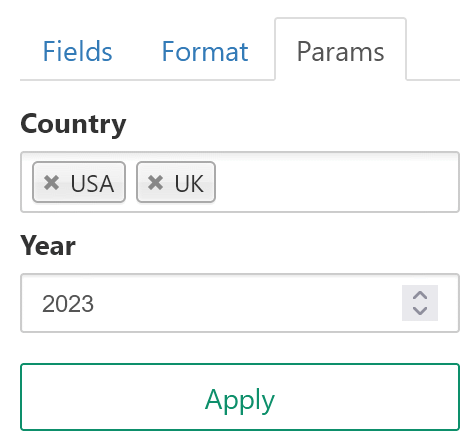
Another way to filter report's data are report parameters. Unlike table's "Filter" these parameters are always applied on a data source level; for instance, for SQL-based cubes these report parameters are converted to query's WHERE conditions. With report parameters it is possible to filter by dataset's columns that are not used in the report.
Report parameters may be configured only explicitly in the cube configuration form; please check your data source type help page for guidance. Params tab appears when at least one report parameter is configured for the cube.
Cells Selection
In SeekTable, you can select cell contents of one or more cells, rows and columns in the same way as you do that in Excel:
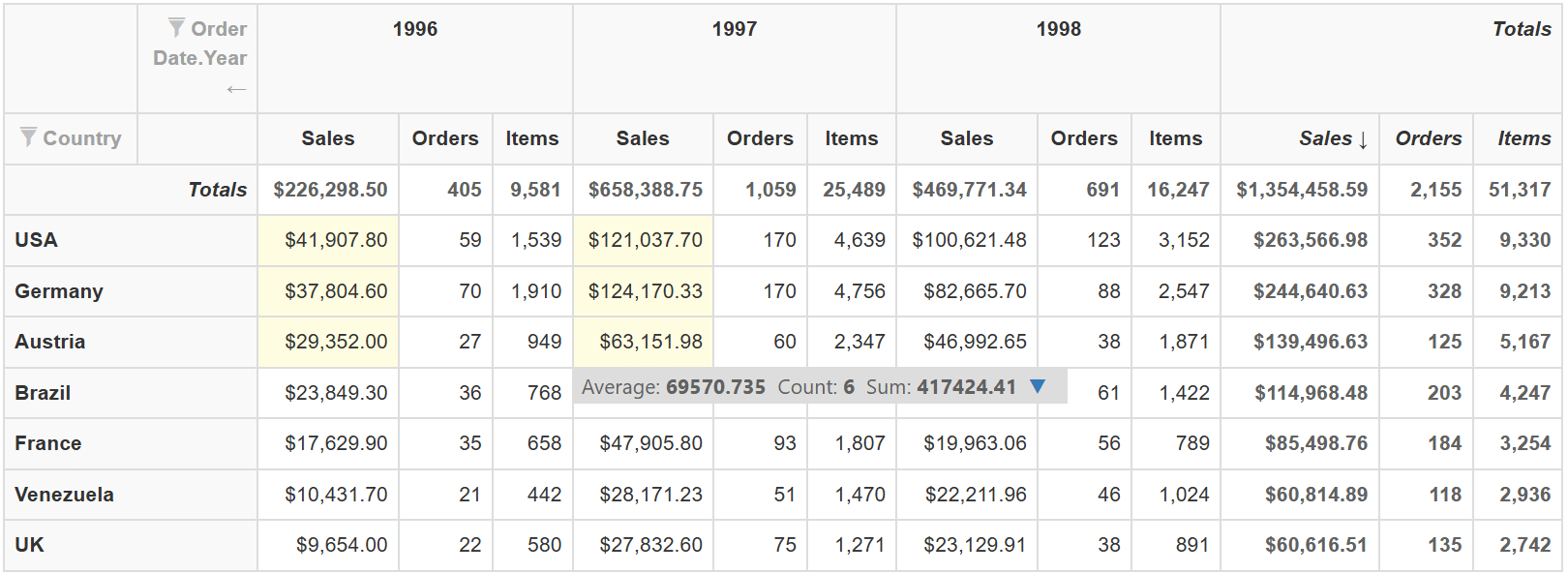
- To select a range, select a cell, then with the left mouse button pressed, drag over the other cells.
- To select non-adjacent cells and cell ranges, hold Ctrl and select the cells.
Similarly, you can unselect selections: hold Ctrl and click the selected cell. - When at least one cell is selected, you can copy selection to the clipboard by pressing Ctrl+C (Cmd+C).
- When 2 or more cells are selected, a tooltip displays some info about selection like in Excel: Count (the number of non-empty selected cells), Average and Sum (only if all cells contain numbers).
Cells Formatting
You can specify custom format for dimension's labels (table's rows & columns headers) and measures (cells with values) in this way:
- Click the "gear" icon near Rows, Columns, Values.
- Specify a custom format for an appropriate item with this pattern:
<prefix> {value_format_specifier} <suffix>wherevalue_format_specifiercan be:For numbers formatting meaning of#→ display only integer part
$#.##→ display numbers as "$50.01" (empty if zero)
$0.00→ display numbers as "$50.01" ("$0.00" if zero)
yyyy-MM-dd→ display dates as 2019-07-15
MMM→ format a month number (1-12) as a short month name (Jan, Feb etc)
MMMM→ format a month number (1-12) as a full month name (January, February etc)
ddd→ format a day-of-week number (0-6) as a short day-of-week name (Mon, Tue etc)
dddd→ format a day-of-week number (0-6) as a full day-of-week name (Monday, Tuesday etc)
0.#|k→ if number>1000 shorten it with "k" suffix
0,.0#→ show number in thousands (value divided by 1000)
0.#|kMB→ shorten large number with an appropriate "k"/"M"/"B" suffix
ifempty=STR→ if value is empty or null show "STR"
#,0,.,,is the same as in Excel. For complete reference on format syntax see .NET String.Format documentation. - Also in this dialog you can specify custom labels if needed.

Drill Down and Expand/Collapse Mode
SeekTable offers great data exploration capabilities with a drill-down function: you can click an any pivot table cell with value and get more detailed view for this concrete group:

Cell's drill-down menu gives you 2 alternatives:
- Show rows: opens a 'flat table' report that is pre-configured to display aggregated records of the group. Use browser's "Back" to return to the original pivot table.
You can open this view in a new tab if you like (this is normal link).
NOTE: "Show rows" option is not available if your pivot table uses expression-type dimensions or dimensions that are not allowed for 'flat table' report type. - Drill down by dimension: you can choose which dimension to use to get more detailed view of the group. As result this dimension will be added to rows (or columns) and "Filter" will be changed to limit pivot table by the rows/columns that correspond to the group:

If you like Excel-like drill down by hierarchy with groups (levels) expand/collapse this is also possible:
- choose dimensions that you want to use as hierarchy for rows and/or columns. Hiearchy for dates might be: "Year", "Month", "Day". For location this could be "Country", "State", "City" and so on.
- Check Enable expand/collapse ("Format" tab) to activate this mode, or simply click the "collapse" link near "Rows" or "Columns".
- Click "+" and "-" to expand/collapse individual groups:

SeekTable supports pagination for collapsed pivot tables. To show all rows and/or columns you may specify explicit Limits ("Format" tab) in the same way as for non-collapsed pivots.
Pivot Table Percentage/Difference/Running Total
To show values as percentages such as "% of Grand Total" or "% of Row Total" or "% of Column Total":
- Open Format tab or click icon near Values (here you can configure a calculation for the concrete measure).
- in the Value Calculations dropdown choose an appropriate option:
% of grand total,% of row,% of column,diff from prev row,% diff from prev row,diff from next row,% diff from next row,diff from prev column,% diff from prev column,diff from next column,% diff from next column,running total by row,running total by column.

For "percentage" calculation it is possible to enable data bars and show percentage in addition to the original cell's value.'
For "diff" calculation additional options are Diff same group only (diff value is shown only if items belong to the same group),
Colors (highlight positives with blue and negatives with red), As suffix (diff value is shown in addition to the original value, as a suffix or below):

Data bars
It is possible to display percentage calculation as data bars that can improve table's readability a lot.
- open Format tab
- ensure that in Value Calculations a percentage option is selected ("% of ...")
- Data bars checkbox appear to control whether percents should be visualized as data bars.
- Click the icon to configure options like color, display value and which cells should have bars (all, values and subtotals, or only values).
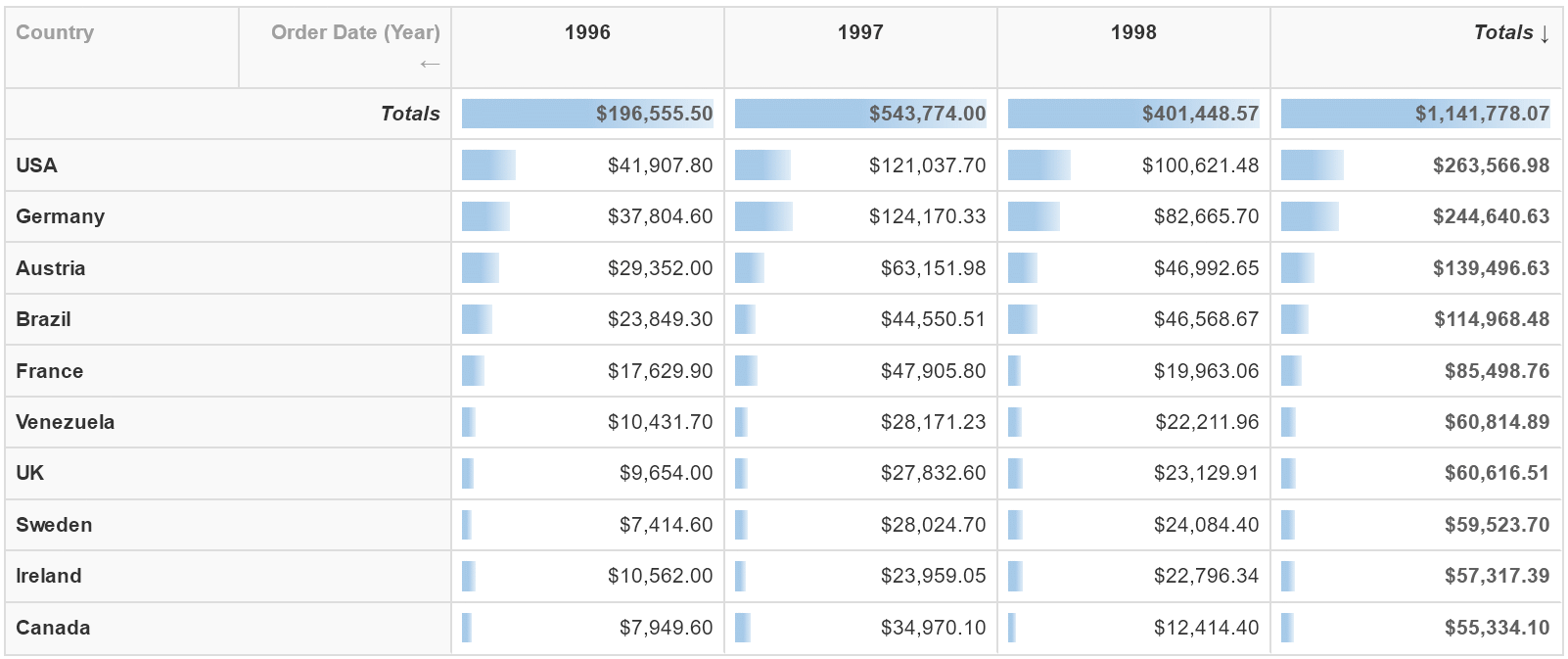
These data bars are preserved in PDF and Excel exports.
Pivot Table Top 10 show only top N (last N) rows and/or columns
To show only first top 10 (or top 5, top 100 etc) results in a pivot table:
- open Format tab
- use appropriate Limits dropdown to apply a top-N filter for either rows or columns or both:
- click the Apply button

All results that are beyond the limit are included into special "..." group. To hide this group you can uncheck Show "..." group when limit .
Alternatively, it is possible to apply "top-N" filter per grouped items separately in the same way as in Excel PivotTables.
This is useful when you want to show, say, top-10 'best' product categories and then top-5 'best' products in each category; to do that it is enough to
add this into Filter textbox: category:top(10), product:top(5) (assuming that the report has "category" and "product" dimensions on the same axis).
Repeat Labels in a Pivot Table
It is possible to repeat labels of grouped items in the same way as you can do that in Excel PivotTable:
- open Format tab
- check either Repeat labels for Rows or Repeat labels for Columns (or both)
- click the Apply button

Exports
SeekTable can export pivot tables to all popular export formats:
- 100% the same as report's web view (custom HTML formatting is preserved), long tables are correctly exported to multiple PDF pages.
- Excel
- Layout is the same as report's web view. Formatting, cells colors and links are preserved.
If chart is enabled, it is also exported as a pre-configured Excel Chart (in a separate worksheet). - Excel PivotTable
- This is a special kind of Excel export:
- report's aggregated (summary) data is exported to a separate "Report Data" worksheet
-
in the main "Report" worksheet a pre-configured Excel PivotTable is created automatically which is based on the summary data from the "Report Data" worksheet.
Note that in Excel some calculations work differently (in particular, "differences" and "percentages") + for SeekTable-calculated measures (Type=Expression) totals may show wrong numbers.
- CSV
- Sub-totals are not exported.
- HTML
- Raw HTML
<table>that can be used anywhere. - Image
- Available in API / published reports.
- JSON
- Available in API / published reports.
By default exports include only data that you see in a web view (current page only, if pagination is used). If you want to export all rows/columns you may check Export all data option, and in this case export will include as much rows as possible (up to 50,000). This limit can be increased in self-hosted SeekTable (see SeekTable_ST__Export__ExportAllDataLimit app setting).
GenAI-assisted analytics
Users can use AI menu to run predefined prompts that include report's table as a context:
- Discovering insights: helps to identify the most important patterns, trends or comparisons within the data.
- Anomaly detection: helps to find anomalies or unusual patterns.
- Ask Report: users can type their own questions to the report.
- [Custom prompt templates]: supported only in on-prem SeekTable deployments.
These prompts may become more valuable for end users when LLM is guided with cube-specific instructions that may be a part of cube's/report's'
"Description"; if these instructions should not be visible by users it is enough to wrap them with a <prompt> tag.
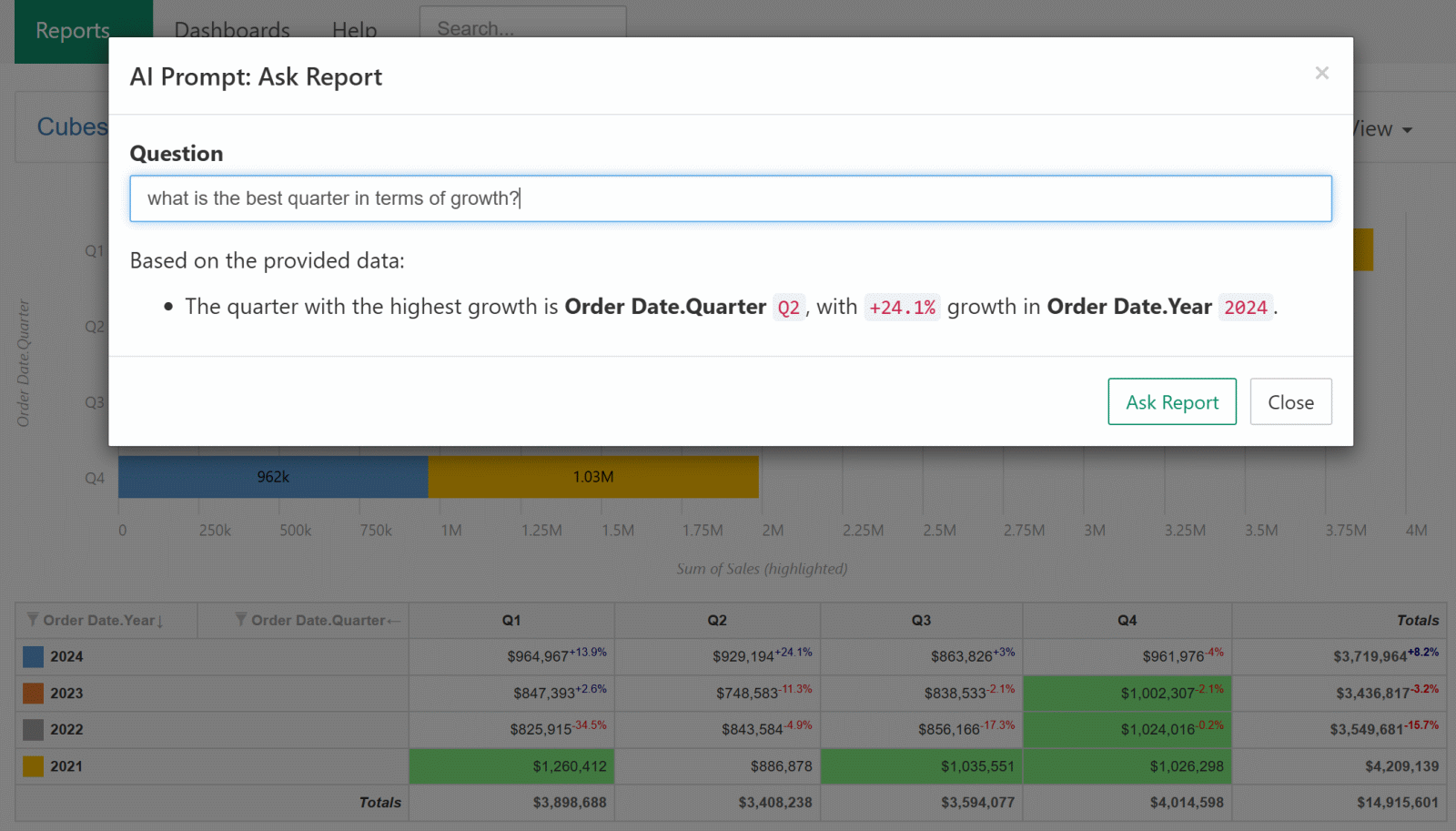
When LLM response contains table's values SeekTable tries to link them to simplify the finding exploration:
- Dimension value: applies a filter.
- Measure value: navigates to this value in the pivot table and automatically selects the cell.
Limitations
-
Max number of value cells in the table (rows x columns): 1,000,000
This limit can be increased in a self-hosted SeekTable. - Max number of rows (unpaginated, non-collapsed): 50,000
- Max number of columns (unpaginated, non-collapsed): 1,000
- Number ranges depending on the measure type:
Countfrom 0 to 4294967295 (uint32) Sum,Average,Quantile(+/-) 79,228,162,514,264,337,593,543,950,335 (up to 29 significant decimal digits) or (from -296 to 296) / 10(0 to 28) (.NET System.Decimal) Variancefrom -1.79769313486232e308 to 1.79769313486232e308 (.NET System.Double) FirstValue,Min,MaxValue's datatype returned from a data source is preserved.